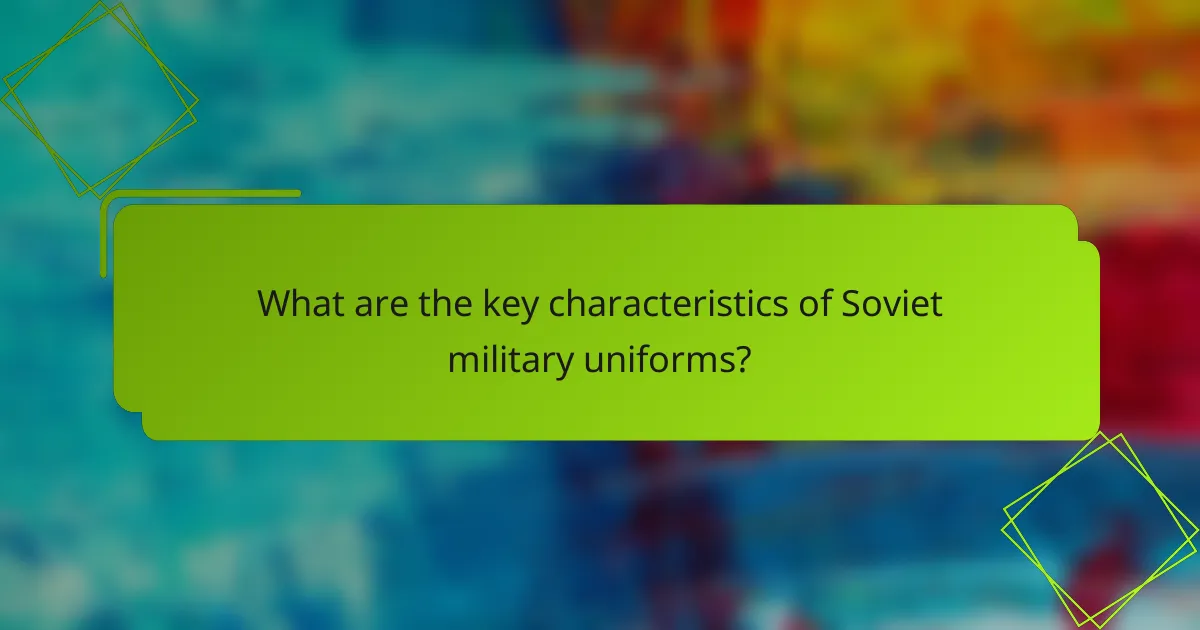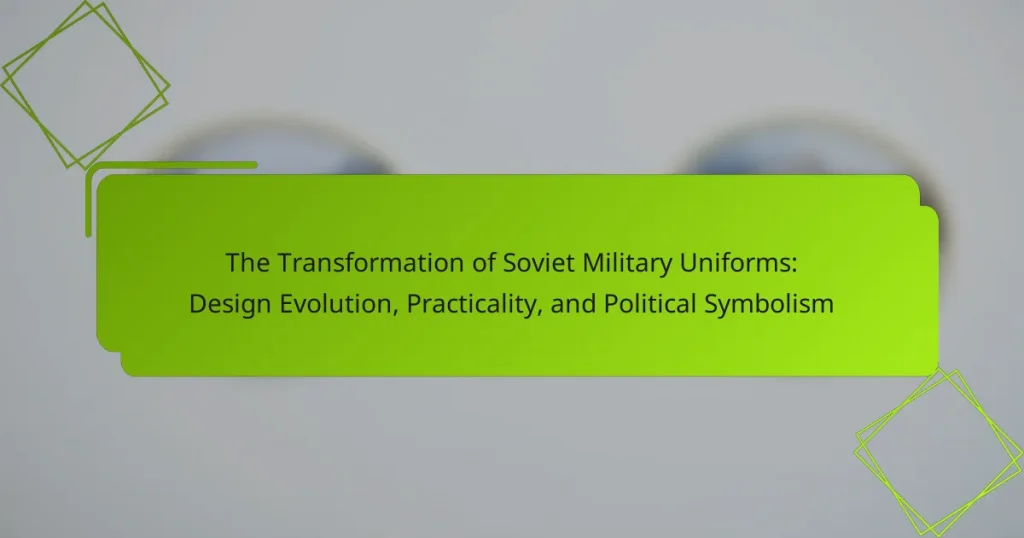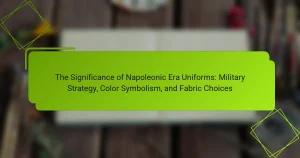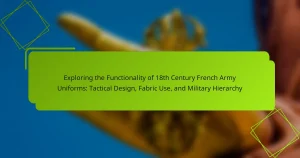Soviet military uniforms are notable for their unique designs, colors, and insignia, primarily featuring olive green and gray tones. These uniforms typically consisted of a tunic, trousers, and a pilotka cap, with rank and branch of service indicated by various badges and shoulder boards. Designed for practicality and adaptability to different climates, the uniforms utilized durable materials while also reflecting political symbolism integral to Soviet identity. The evolution of these uniforms spans from the early 20th century through World War II, showcasing their adaptation to the changing needs of the military.

What are the key characteristics of Soviet military uniforms?
Soviet military uniforms are characterized by distinctive designs, colors, and insignia. The uniforms typically featured a combination of olive green and gray colors. They often included a tunic, trousers, and a cap known as a pilotka. Insignia such as badges and shoulder boards indicated rank and branch of service. The uniforms were designed for practicality and functionality, with durable materials suitable for various climates. Additionally, the design reflected political symbolism, showcasing the Soviet identity. Historical context shows that these uniforms evolved from the early 20th century through World War II, adapting to changing military needs.
How did the design of Soviet military uniforms evolve over time?
The design of Soviet military uniforms evolved significantly from the early 20th century to the dissolution of the USSR in 1991. Initially, uniforms were influenced by Imperial Russian styles, featuring elaborate designs and ornate decorations. During the Russian Civil War (1917-1922), practicality became essential, leading to simpler, more functional designs. The 1930s introduced standardized uniforms that emphasized military rank and identity, often adorned with insignia.
World War II saw further evolution, with uniforms designed for durability and comfort in harsh conditions. Post-war designs incorporated elements of modernity, reflecting Soviet ideology and national pride. The 1960s and 1970s marked a shift towards more utilitarian styles, focusing on camouflage and functionality for various military branches.
Throughout this period, uniforms also served as symbols of political power and national identity. Changes in design often mirrored shifts in military doctrine and political climate, reinforcing the connection between the military and state ideology.
What historical events influenced changes in uniform design?
The design of military uniforms has been significantly influenced by various historical events. The Russian Revolution of 1917 led to the establishment of the Red Army, prompting a need for new uniforms that symbolized the revolutionary ideals. World War II necessitated practical designs for combat effectiveness, resulting in the adoption of more functional materials and styles. The Cold War era introduced uniforms that reflected ideological stances, emphasizing a distinct Soviet identity. Additionally, the dissolution of the Soviet Union in 1991 brought about modernization efforts, leading to updated designs that aligned with contemporary military standards. Each of these events played a crucial role in shaping uniform design to meet the needs of the military and reflect the political climate of the time.
How did technological advancements impact uniform materials and styles?
Technological advancements significantly transformed uniform materials and styles. Innovations in textile manufacturing introduced synthetic fibers like nylon and polyester. These materials offered durability and resistance to environmental factors. Enhanced dyeing techniques allowed for vibrant colors and patterns. Development in manufacturing processes reduced production costs and time. Advances in design technology enabled precise tailoring and fit. These changes led to more functional and comfortable uniforms for soldiers. Historical records show that these advancements improved the overall effectiveness of military attire.
What practical considerations shaped the design of Soviet military uniforms?
Soviet military uniforms were shaped by practical considerations such as functionality, durability, and climate adaptability. The design prioritized ease of movement for soldiers in various combat situations. Fabrics used were typically heavy-duty to withstand harsh conditions. Uniforms also featured pockets for carrying essential gear. The color palette was selected to provide camouflage in diverse environments. Additionally, the design aimed to promote a sense of unity and discipline among troops. Historical context reveals that uniforms evolved in response to the needs of World War II and subsequent conflicts. Overall, these considerations ensured that uniforms were both practical and effective for military operations.
How did climate and geography affect uniform functionality?
Climate and geography significantly influenced the functionality of Soviet military uniforms. The harsh climate of Russia, characterized by extreme cold and varied terrain, necessitated the use of durable and insulating materials. For instance, wool and fur were commonly used for winter uniforms to provide warmth. Geography also played a role in design adaptations for mobility across different landscapes. Uniforms had to accommodate diverse environments, from snowy plains to rugged mountains. Historical instances, such as the Winter War of 1939-1940, highlighted the need for functional designs that could withstand severe weather conditions. These adaptations ensured that soldiers remained effective in various operational contexts.
What role did rank insignia and identification play in uniform design?
Rank insignia and identification are crucial elements in uniform design. They serve to denote hierarchy and rank within military structures. Insignia provide immediate visual cues about a soldier’s position and authority. This clarity enhances command and discipline among troops. Historically, different insignia styles evolved to reflect changes in military organization. For example, the introduction of specific colors and shapes indicated various ranks. This system helped streamline communication on the battlefield. Additionally, identification elements fostered a sense of unity and belonging among service members. Overall, rank insignia and identification significantly shaped the functionality and symbolism of military uniforms.
What political symbolism is embedded in Soviet military uniforms?
Soviet military uniforms embodied political symbolism representing power, ideology, and national pride. The use of specific colors, such as red, signified the communist revolution and the blood of martyrs. Insignia and medals were designed to reflect loyalty to the state and the party’s hierarchy. The uniform’s design emphasized discipline and unity among soldiers. Epaulettes and rank insignia highlighted the military’s structure and authority. The overall aesthetic aimed to project strength and resilience against perceived enemies. Historical context shows that uniforms evolved to align with changing political narratives, reinforcing the regime’s ideals.
How did uniforms reflect the ideology of the Soviet regime?
Uniforms in the Soviet regime symbolized collectivism and state authority. The design emphasized uniformity, eliminating individual expression. This reflected the regime’s ideology of equality among citizens. Military uniforms were often adorned with insignia that represented loyalty to the state. The colors used, primarily red and green, were associated with revolution and military strength. Additionally, the practical design catered to functionality in various environments. Historical context shows that uniforms were a means of instilling discipline and unity. They served as a visual representation of the Soviet identity and values.
What messages were conveyed through color and insignia choices?
Color and insignia choices in Soviet military uniforms conveyed messages of authority, unity, and ideological commitment. The use of red symbolized revolution and the blood of martyrs. Insignia often represented rank and unit affiliation, fostering a sense of belonging among soldiers. Dark colors like green and black were chosen for practicality and camouflage, enhancing operational effectiveness. Bright colors were reserved for ceremonial purposes, emphasizing pride and tradition. The design evolution reflected changing political contexts, aligning with the Soviet Union’s shifting ideologies. Historical analysis shows that these choices were meticulously crafted to project power and instill loyalty among troops.
How did the transformation of Soviet military uniforms relate to broader military reforms?
The transformation of Soviet military uniforms was closely tied to broader military reforms aimed at modernization and efficiency. These reforms emerged during the late 1940s and 1950s, reflecting a shift in military strategy and ideology. The new uniforms emphasized practicality and functionality, aligning with the Soviet Union’s need for a more mobile and effective military force.
This shift included the adoption of lighter materials and streamlined designs, which enhanced soldier mobility. Additionally, the changes symbolized a break from the traditional, ornate uniforms of the past, representing a modernized military image. The reforms were part of a larger effort to improve morale and cohesion among troops.
The introduction of standardized uniforms also facilitated better identification and unity among soldiers. Overall, the transformation of military uniforms illustrated the Soviet Union’s commitment to reforming its armed forces in response to contemporary military challenges.
What lessons can be learned from the evolution of Soviet military uniforms?
The evolution of Soviet military uniforms teaches several key lessons. Firstly, adaptability is crucial in military design. Uniforms evolved to meet changing combat environments and technological advancements. Secondly, symbolism plays a significant role. Uniforms conveyed political ideology and national identity. Thirdly, functionality is essential. Practical features improved soldier performance and comfort. Lastly, historical context influences design. Uniforms reflected the political and social climate of their time. These lessons highlight the importance of design evolution in military history.
How can modern military organizations apply these insights to their uniform designs?
Modern military organizations can apply insights from the transformation of Soviet military uniforms to enhance functionality and symbolism in their designs. Historical adaptations show the importance of practicality in various environments. For instance, Soviet uniforms incorporated camouflage patterns that improved concealment in diverse terrains. This approach can guide current designs to prioritize environmental adaptability.
Additionally, the use of materials that balance durability and comfort was crucial in Soviet uniforms. Modern military organizations should consider advanced textiles that offer breathability and moisture-wicking properties. The emphasis on symbolism in Soviet uniforms also highlights the need for designs that foster unit cohesion and national identity. Incorporating elements that reflect heritage can strengthen morale among personnel.
Overall, by integrating these historical insights, modern military organizations can create uniforms that are both practical and representative of their values.
What are the best practices for balancing tradition and practicality in military uniforms?
Best practices for balancing tradition and practicality in military uniforms include integrating historical elements with modern materials. Military uniforms should retain recognizable insignia and colors that symbolize heritage. However, using breathable, durable fabrics enhances functionality. Design should accommodate diverse body types for comfort and mobility. Incorporating modular features allows customization for various environments. Regular feedback from personnel ensures uniforms meet practical needs while respecting tradition. Historical studies show that successful military uniforms blend identity with operational efficiency. This approach fosters pride and effectiveness in service members.
The main entity of the article is Soviet military uniforms, which underwent significant transformation in design, practicality, and political symbolism from the early 20th century to the dissolution of the USSR in 1991. The article outlines key characteristics of these uniforms, including their distinctive colors, materials, and insignia that indicated rank and branch of service. It discusses the evolution of uniform design influenced by historical events such as the Russian Revolution and World War II, as well as technological advancements that improved functionality. Additionally, the article highlights how uniforms reflected Soviet ideology and identity, serving as symbols of power and unity among troops, while also addressing practical considerations for diverse climates and operational effectiveness.




